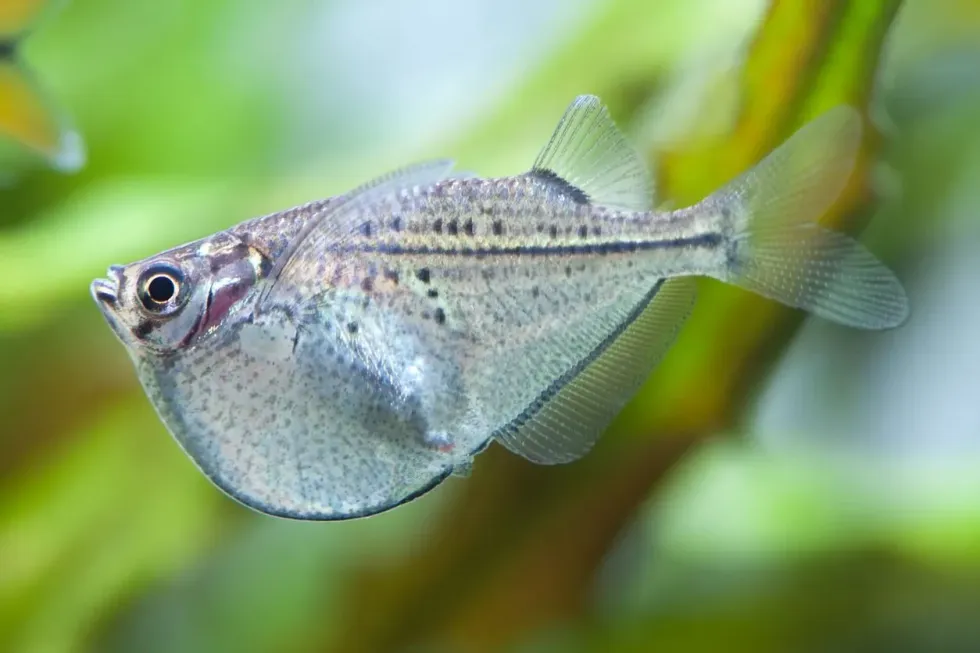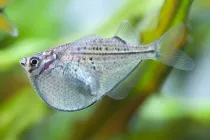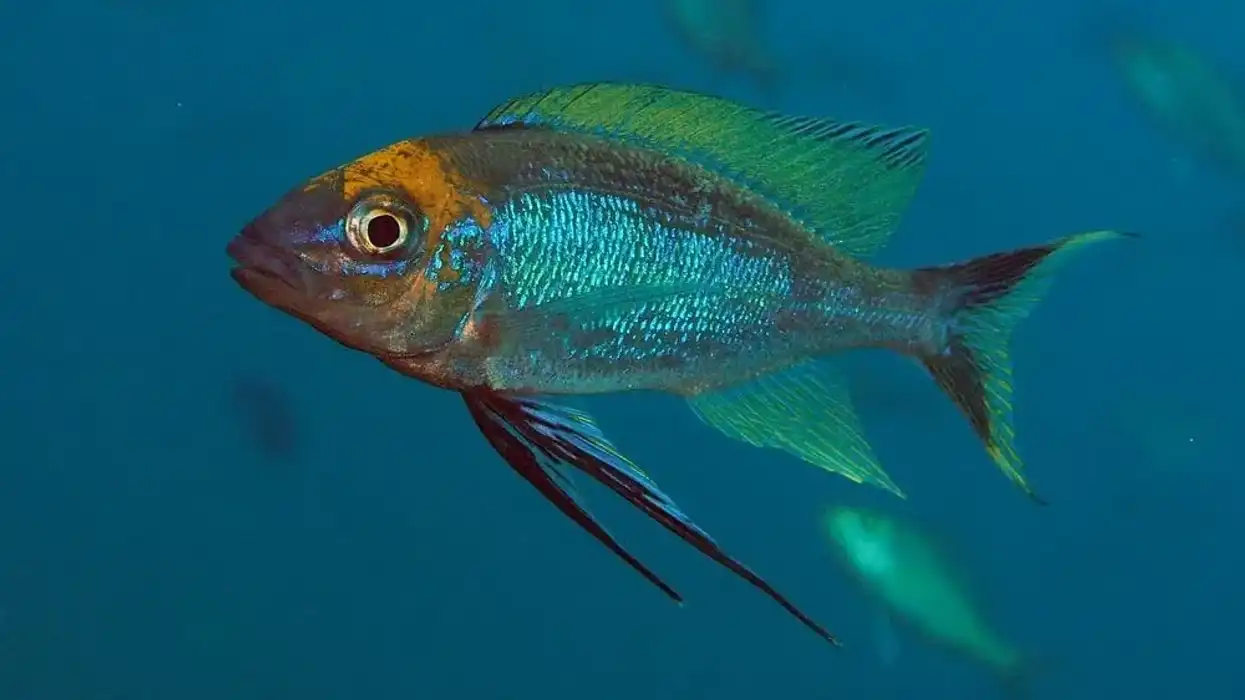Fun Hatchetfish Facts For Kids
A Hatchetfish or flying fish, with the scientific name of Gasteropelecus sternicla, is a type of fish that lives both in freshwater and deep oceans. They are called flying fish as they have really strong fins that help them jump quite high in the upward direction to catch their prey above the water layer.
One of the facts about Hatchetfish is that they can glow in the dark like some other deep-sea fishes that are luminous. A deep-sea Hatchetfish can glow in the dark with the help of bioluminescent light organs that can help them find food and distract predators using light.
These fish are shy and hence generally stay in groups. Under captive conditions, their chance of survival increases by 80% if kept in six or more groups of the same species and type.
The fish gets its name from its protruding belly which is in the shape of a hatchet. When alarmed or in trouble, they jump out of the water.
To find out more interesting facts and information about other animals, you can also check our guides on the pearl danio and peacock cichlid for more enriching and mind-blowing facts and guides.
Hatchetfish Interesting Facts
What type of animal is a Hatchetfish?
A Hatchetfish (Gasteropelecus sternicla), belonging to the family Gasteropelecidae, is a species of fish that can be found in deep water and freshwater. The fish got its name because of its unique hatchet-like appearance.
There are different Hatchetfish species, like the silver Hatchetfish (Gasteropelecus sternicla), Marbled Hatchetfish (Carnegiella strigata), deep-sea Hatchetfish, common or freshwater Hatchetfish, and Pygmy Hatchetfish. There are nine different species of Hatchetfish.
What class of animal does a Hatchetfish belong to?
This fish belongs to the Actinopterygii class, consisting of the members of ray-finned fishes (like red mullets) of different fish species. The Hatchetfish species include nine different species of Hatchetfish spread across three genres.
How many Hatchetfish are there in the world?
There are nine different species of Hatchet fish spread across three genres across the world. They are mainly found in North and South America, and the types found are marine or deep-sea Hatchetfish, freshwater Hatchetfish, silver Hatchetfish, and marbled Hatchetfish. There are 45 different species of Hatchetfish in total.
Where does a Hatchetfish live?
The species of Hatchetfish live in different surroundings and environments. Common Hatchetfish or freshwater Hatchetfishes are found in the Amazon, Venezuela, Peru, Guyana, and Surinam. Some species of Hatchetfishes can be found in subtropical and temperate waters of the Indian Ocean, Atlantic Ocean, and Pacific Ocean and are called marine Hatchetfish.
What is a Hatchetfish's habitat?
Hatchetfishes can live in the wild as well as in an aquarium or a tank.
Common or freshwater Hatchetfishes like the silver Hatchetfish are known for living on the surface of the water and hide in floating plants on the surface of the water, be it in an aquarium or a tank, as they are shy and take refuge in floating plants or greens in the wild.
Therefore, it is always suggested for people who are keeping them in their houses in an aquarium or tank to mimic their natural habitat.
They are sensitive to ammonia and cannot survive in hard water. Proper and complex care needs to be taken when common Hatchetfishes are kept in an aquarium or a tank.
Under home conditions, they need a 20 gal (75 l) aquarium or a tank to survive, with a proper pH level of water.
They thrive best when they are kept in groups of six or eight. In the oceans, they are usually found in the photic zone.
Who do Hatchetfish live with?
Hatchetfish generally lives in small groups of six to eight members and thrive best under these conditions, be it in the wild or under home conditions in an aquarium or a tank. They can also be kept in a group of 10 or more under the proper water pH levels and conditions.
A single hatchet has relatively lower chances of survival. They get very shy and lonely and hence prefer living in groups.
How long does a Hatchetfish live?
Generally, Hatchetfish species, under rough conditions, can live up to three years. Under captive conditions in an aquarium or a tank, if taken proper care of and provided with ideal water conditions and a regular food supply, they can survive up to five years of age.
How do they reproduce?
Common Hatchetfishes cannot be bred in captivity, but in contrast to that, marbled Hatchetfish can be bred or reproduced easily in captivity. It's hard to differentiate between male and female Hatchetfish as these flying fish do not exhibit sexual dimorphism.
These fish are egg-layers. We know that Hatchetfish stays on the water surface and hide behind plants floating on the surface; thus, they love to deposit and lay their eggs on the plants floating on the surface.
The eggs of Hatchetfish generally hatch in two days, and new Hatchetfish are born. It is suggested that the male and female Hatchetfish should be kept in another tank after the females lay the eggs as they might eat the eggs.
Successful breeding of marbled Hatchetfish is only possible in captivity. Common and silver Hatchetfish cannot breed in captivity, and how they reproduce in the wild is still unknown.
What is their conservation status?
Hatchetfishes are found in abundance in South and North America. All their species are well conserved and not endangered in both wild and captive conditions; thus, their conservation status is of Least Concern, and we need not worry too much about their protection.
Hatchetfish Fun Facts
What do Hatchetfish look like?
A Hatchetfish possesses a sleek body with a bloated belly portion that looks like a hatchet, giving them its unique name that embraces its hatchet-like appearance. They have powerful pectoral fins on the upper part of their body.
The mouth is situated on the upper portion of the head. The deep-sea hatchet fish have bioluminescent light organs that can help them find food and distract predators with the help of light. Common or silver Hatchetfishes are a bit larger.
Different species of Hatchetfish have different colored patterns on their body. Standard or silver Hatchetfish has a silver and gray tint with black stripes on their body. Marbled Hatchetfish has bronze strips with a gray and black tint.
They have big eyes to catch their surface prey quickly in their natural habitat. Others have different colors as they have adapted differently to light, temperature, pH levels, and diet.

How cute are they?
You can keep them as your pet in a small aquarium or tank, and they look very good, especially in groups of six or more members with black, gray, and bronze strips and tints.
How do they communicate?
There is not much information about Hatchetfish communication, but it is known that they communicate through their actions and behavior and their fin movements. They are naturally shy, and hence you need to be careful and keep them with other fish species. Make sure that their companion fish species do not dominate and attack them.
How big is a Hatchetfish?
Different species of Hatchetfish have different sizes. Some are big, and some are small. The average size range of Hatchetfishes can range from 1.25-2.5 in (3.2-6.5 cm) in size and length. They have big bulky bodies. Common Hatchetfishes are generally bigger as compared to other species of Hatchetfishes.
How fast can a Hatchetfish swim?
Hatchetfishes are known for their super-strong pectoral fins that help them to swim fast in the upward direction leaping up to 5 ft (1.5 m) in height to catch an insect preying on the surface of the water. There are known for swimming on the surface of the water at an excellent speed.
They can catch their prey easily without much effort and can take refuge beneath the plants floating on the surface. Their exact speed, however, is not known.
How much does a Hatchetfish weigh?
The average weight of Hatchetfishes is not known, but they weigh relatively less, judging by their appearance and ninja-like speed.
What are the male and female names of the species?
There are no such designated names for males and females of the Hatchetfish. They are referred to as the male and female Hatchetfish, respectively.
What would you call a baby Hatchetfish?
There is no such designated specific name for a baby Hatchetfish. A baby Hatchetfish can be referred to as a young Hatchetfish or a Hatchetfish fry.
What do they eat?
Hatchetfish is generally carnivores in nature and can eat small plankton, small insects above the water level, mosquito larvae, crustaceans, and small tiny worms (like flatworms), shrimps, crustaceans, and insects consist of 90% of their diet in the wild. Under captive conditions, in an aquarium, feeding them is not a big issue.
You can feed them small dried food, live and frozen small insects like nauplii, daphnia, Moina, fruit flies, fish flakes, and other such items. Feeding them requires patience and effort.
Are they dangerous?
The Hatchetfish are not venomous, and hence they are not at all dangerous for humans. They are pretty shy and hence are easily dominated by other big fish species if they are kept in the same tank as tankmates.
Thus, they are safe for humans and can be kept in aquariums and tanks. They are also not considered aggressive, except for the marbled Hatchetfish that get aggressive with other fish because they are territorial.
Would they make a good pet?
Yes, they can make a good pet. Common Hatchetfish is kept primarily in captivity only.
They are kept in groups of six or more members. Having tankmates increases their chances of survival. They require a lot of care: you need to check the hardness of the water, the pH level of the water, and the water temperature at regular intervals to make sure it's not too alkaline.
They can survive easily in aquariums. Feeding is not a big deal, but feeding and breeding together can be an issue, and it is advised that people who are experienced with fish should start with a few Hatchetfish as their pets.
Did you know...
One of the deep-sea Hatchetfish facts is that deep-sea Hatchetfish can regulate the amount of light reflected from their body with the help of their bioluminescent light organs. It helps them camouflage with their surroundings and helps them escape from their predators by tricking them with their light patterns.
One of the freshwater Hatchetfish facts is that the breeding pattern of these common Hatchetfish is still unknown, so they cannot be bred under captive conditions by humans.
Want more fun facts about Hatchetfish? A marbled Hatchetfish can jump up to 5 ft (1.5 m) high in water, almost capable of flying!
Different types of Hatchetfish
There are different types of Hatchetfish. There are nine other species of Hatchetfish across three different genres, with a total of 45 species.
There are freshwater Hatchetfishes and marine or deep sea Hatchetfish, common Hatchetfishes, silver Hatchetfish, pygmy Hatchetfish, marbled Hatchetfish, black-winged Hatchetfish with black fins, and others. All have different color patterns and strips and can be found in different subtropical rivers and oceans.
Can you keep Hatchetfish?
Yes, you can keep a Hatchetfish as your pet, but caring for them is considered difficult as they require a lot of care and precautions. You should always keep Hatchetfishes in groups of six or above and, if possible, from the same species.
They start to endure stress if the hardness of the water is not ideal.
They can be kept in 20 gal (75 l) water tanks with moderate light and temperature. The pH range should be between six and seven, the hardness range should be low, water movements should be normal, and you should change the water at regular intervals.
Here at Kidadl, we have carefully created lots of interesting family-friendly animal facts for everyone to discover! Learn more about some other fishes from our Nile perch fun facts and john dory interesting facts pages.
You can even occupy yourself at home by coloring in one of our free printable Hatchetfish coloring pages.
We Want Your Photos!
More for You
See All
Bachelor of Commerce specializing in Accounting and Finance, Master of Business Administration

Divya RaghavBachelor of Commerce specializing in Accounting and Finance, Master of Business Administration
With a diverse range of experience in finance, administration, and operations, Divya is a diligent worker known for her attention to detail. Born and raised in Bangalore, she completed her Bachelor's in Commerce from Christ University and is now pursuing an MBA at Narsee Monjee Institute of Management Studies, Bangalore. Along with her professional pursuits, Divya has a passion for baking, dancing, and writing content. She is also an avid animal lover who dedicates her time to volunteering for animal welfare causes.
Disclaimer
1) Kidadl is independent and to make our service free to you the reader we are supported by advertising. We hope you love our recommendations for products and services! What we suggest is selected independently by the Kidadl team. If you purchase using the Buy Now button we may earn a small commission. This does not influence our choices. Prices are correct and items are available at the time the article was published but we cannot guarantee that on the time of reading. Please note that Kidadl is a participant in the Amazon Services LLC Associates Program, an affiliate advertising program designed to provide a means for sites to earn advertising fees by advertising and linking to Amazon. We also link to other websites, but are not responsible for their content.
2) At Kidadl, we strive to recommend the very best activities and events. We will always aim to give you accurate information at the date of publication - however, information does change, so it’s important you do your own research, double-check and make the decision that is right for your family. We recognise that not all activities and ideas are appropriate for all children and families or in all circumstances. Our recommended activities are based on age but these are a guide. We recommend that these ideas are used as inspiration, that ideas are undertaken with appropriate adult supervision, and that each adult uses their own discretion and knowledge of their children to consider the safety and suitability. Kidadl cannot accept liability for the execution of these ideas, and parental supervision is advised at all times, as safety is paramount. Anyone using the information provided by Kidadl does so at their own risk and we can not accept liability if things go wrong.
3) Because we are an educational resource, we have quotes and facts about a range of historical and modern figures. We do not endorse the actions of or rhetoric of all the people included in these collections, but we think they are important for growing minds to learn about under the guidance of parents or guardians.







